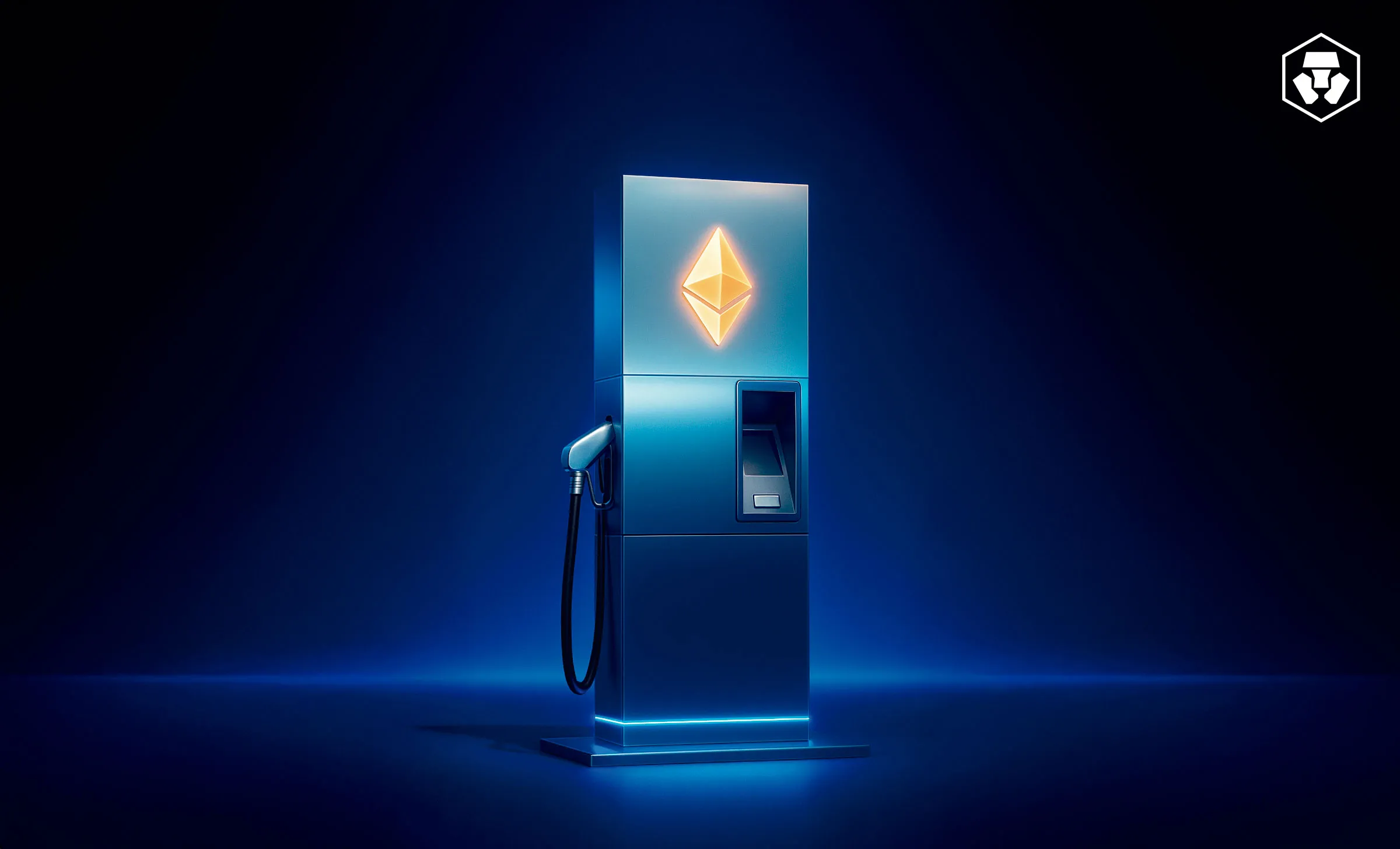ETH gas fees: what are Ethereum gas fees?
In the world of blockchain, every transaction comes with a cost, known as a ‘gas fee’. In this article, we explain the importance of gas for the Ethereum blockchain.
 Nic Tse
Nic Tse
In the world of blockchain, every transaction comes with a cost, known as a ‘gas fee’. In this article, we explain the importance of gas for the Ethereum blockchain.
Key takeaways:
- ‘Gas’ (or a ‘gas fee’) is the unit that measures the computational effort for executing different types of actions while interacting with a blockchain.
- Every action on Ethereum, from simple transactions to deploying smart contracts, uses gas.
- Users must pay for this computational work in the form of a ‘gas fee’, usually with the network’s native currency.
- Gas prices, quoted in Gwei on the Ethereum network, fluctuate based on network congestion, affecting transaction costs.
- Validators play a pivotal role by validating and processing transactions, earning gas fees as rewards.
At first glance, gas might evoke thoughts of fuel and energy, a good metaphor for what it represents in the cryptocurrency world, as it plays a major role in determining transaction speed, transaction cost, and the overall efficiency of a blockchain. But what exactly is gas and why is it so crucial to the success of a blockchain network? In this article, we explain the importance of gas and gas fees in the blockchain space.
What is Ethereum gas and what is it used For?
A commonly used term in the blockchain and cryptocurrency landscape, ‘gas’ is the cost of a transaction on the Ethereum network. All transactions on the blockchain are powered by gas and subject to gas fees based on the gas limit and gas price, which help ensure they are processed securely and efficiently.
Since each transaction on Ethereum requires computational resources to execute, gas fees are used to incentivise validators to validate the transactions, which helps prevent bad actors from spamming the network. The gas fee is the amount of gas used to perform an operation, multiplied by the cost per unit gas. Gas fees are paid using ETH, the native token of the Ethereum network, regardless of whether the transaction succeeds or fails.
On Ethereum, gas prices are quoted in Gwei, which represent fractional pieces of gas; one Gwei is equal to 0.000000001 ETH. The term is a contraction of ‘giga-wei’, meaning ‘billion wei’, which is inspired by Wei Dai, a computational scientist who worked in the cryptography research department at Microsoft (‘Wei’ is the smallest denomination of Ether).
How does gas work and why is it important?
Gas is defined as the unit of measurement for the computational power to perform tasks on the network. Simply put, it is the cost to perform transactions on the Ethereum blockchain. Many types of protocols in the Ethereum network require the use of gas in order to perform on the blockchain. For example, decentralised apps (dapps), non-fungible tokens (NFTs), and transfers of funds all require the use of gas for on-chain transactions.
Gas also acts as a way to reward validators and those who uphold the network and provide services. Additionally, gas helps combat spam: Without it, malicious actors could spam the network by simultaneously sending a massive amount of transactions, essentially clogging the network.
The gas price depends on the type of transaction and level of congestion on the blockchain network while the transaction is processing. The more users trying to complete transactions at the same time, the higher the gas price.
Gas fees can vary greatly — as seen in the chart above.
Gas and the Ethereum blockchain
Users can choose the price at which they set their gas fee. Paying more ETH for gas may allow for quicker transaction completion. Users should be aware that the initial transaction may also fail, and the gas spent to execute it is lost.
If users choose to use less gas, the transaction may take longer to complete; sometimes, it may be upheld, as many validators typically choose transactions that provide more ETH incentives. This frequently happens during times of high traffic, with many trying to get their transactions through as quickly as possible.
Always check current gas prices on the Ethereum network to know how much Gwei (gas fee) is needed to make a transaction. While gas can be tricky, it is an essential part of the Ethereum ecosystem, as it keeps the network working.
What are ETH gas fees?
ETH gas fees are the transaction fees paid to validators on the Ethereum network for processing transactions and executing smart contracts. These fees are calculated based on the complexity of the transaction and the demand on the network while processing, with higher demand leading to increased fees. Unlike fixed transaction fees in some other cryptocurrencies, such as Bitcoin, Ethereum’s gas fees dynamically fluctuate and can become quite high during periods of network congestion.
Ethereum’s transition to Ethereum 2.0 was aimed to address these high gas fees by moving to a Proof of Stake (PoS) consensus mechanism, which has enhanced scalability and reduced transaction costs over time. This variability and the ongoing efforts to optimise it distinguish ETH gas fees from the more static fee structures seen in other blockchain networks.
How to use gas in a transaction
Below is a breakdown of how gas is spent in a transaction on the Ethereum network:
- Purpose: Every action on the Ethereum network, like sending a transaction or interacting with a smart contract, requires computational work. This work is measured by ‘gas’.
- Cost: Gas isn’t free, as users of blockchain networks must pay a fee for the computational work done on the blockchain; this is known as the ‘gas fee’.
- Payment Token: Gas fees are usually paid by the network’s native token. For Ethereum, the ETH token is used to pay gas fees; for Cronos, CRO is used to pay for gas fees.
- Gas Price: The amount of gas required to execute a transaction varies, based on the gas price, known as Gwei. When the network is congested, gas prices are higher.
- Validators: In return for validating transactions on the blockchain, validators are compensated with ETH gas fees as rewards. This serves as an incentive for them to validate transactions.
Ultimately, gas serves as a crucial mechanism for the efficiency of blockchains. It ensures users are able to perform transactions, prevents spam on the network, and incentivises validators to keep the network secure and operational.
High gas fees and how to save on gas
- Timing: Avoid executing transactions during peak times; there are different tools to use for insight on gas prices.
- Using Layer-2 solutions: Built on top of the main blockchain, Layer-2s are secondary layers that aim to relieve the transactional load on the mainchain.
- Adjusting gas prices: Some wallets allow users to manually adjust the gas price to what they’re willing to pay. Setting a lower gas price may save on the transaction fee at the expense of slower transaction processing.
While it’s important to save on gas fees, it’s equally important to ensure the transaction is processed. Setting the gas price too low may result in the transaction getting stuck without processing.
While gas can be tricky, it is an essential part of the Ethereum ecosystem. It is how the network keeps working. As the cryptocurrency space continues evolving, many improvements continue across the industry, including making transaction costs cheaper and faster. Thanks to Layer-2 protocols, this is now a reality. However, before trading, consider checking gas prices first.
Important information:This is informational content sponsored by Crypto.com and should not be considered as investment advice. Trading cryptocurrencies carries risks, such as price volatility and market risks. Before deciding to trade cryptocurrencies, consider your risk appetite. Services, features and other benefits referenced in this article may be subject to eligibility requirements, token holdings, and may change at the discretion of Crypto.com.
Past performance may not indicate future results. There's no assurance of future profitability, and content may not reflect current opinions.
Share with Friends
Ready to start your crypto journey?
Get your step-by-step guide to setting upan account with Crypto.com
By clicking the Submit button you acknowledge having read the Privacy Notice of Crypto.com where we explain how we use and protect your personal data.
